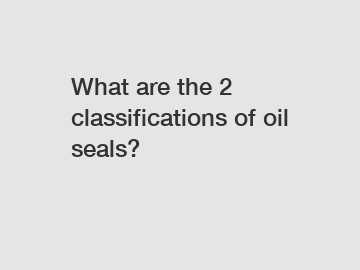What are the 2 classifications of oil seals?
The two classifications of oil seals are dynamic seals and static seals. Let's delve into the origins, significance, and implications of these classifications.
Dynamic seals, as the name suggests, are used to prevent leakage of fluid between moving parts. These seals are designed to withstand motion and maintain a tight seal even when there is relative movement between components. They are commonly found in rotating shafts, such as those in engines, pumps, and gearboxes. Dynamic oil seals typically have a specialized lip design that ensures minimal friction and wear, enabling them to effectively retain lubricants while excluding contaminants.
On the other hand, static seals are used to prevent fluid leakage in stationary or non-moving applications. These seals are commonly found in environments where external elements or environmental conditions can compromise the integrity of a system. Static oil seals are designed to create a barrier between two stationary surfaces, preventing the passage of fluids or gases. These seals are commonly used in applications such as pipe connections, flanges, and hydraulic cylinders.

The classification of oil seals into dynamic and static categories arises from the fundamental understanding of their behavior and purpose. This categorization allows engineers and designers to make informed decisions when selecting the appropriate seal for a specific application. By distinguishing between dynamic and static seals, they can address different sealing requirements and optimize performance.
The significance of classifying oil seals lies in the understanding that each classification has distinct design requirements and performance characteristics. Dynamic seals need to accommodate movements between components without compromising performance, while static seals need to withstand external influences without leakage. By categorizing oil seals into these two classifications, manufacturers can develop specialized designs and materials that cater to the specific demands of each application. This improves overall system efficiency and reliability, reducing the chances of failures or costly repairs.
Furthermore, the classifications of oil seals have a cascading effect on various industries and sectors. Better understanding and classification of oil seals lead to improvements in equipment design, resulting in more efficient and durable systems. This, in turn, enhances productivity, reduces maintenance costs, and extends the lifespan of machinery. Additionally, the ability to classify oil seals aids in aftermarket repairs and replacements, ensuring compatibility and ease of installation.
In conclusion, the two classifications of oil seals are dynamic seals and static seals. Their origins stem from the need to address different sealing requirements in moving and stationary applications. This classification allows for improved seal design, optimized performance, and enhanced equipment reliability. The impact of classifying oil seals extends to various industries, offering improved productivity, decreased maintenance costs, and prolonged machinery lifespan.
Contact us to discuss your requirements of double lip oil seal, oil seal end cap, nok manufacturing. Our experienced sales team can help you identify the options that best suit your needs.
133
0
0


Comments
All Comments (0)